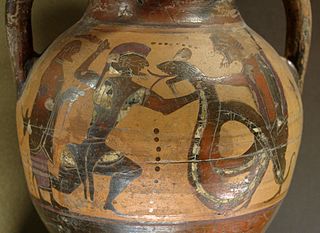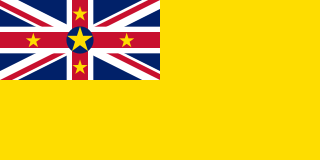
In Greek mythology, Daedalus was a skillful craftsman and artist, and was seen as a symbol of wisdom, knowledge, and power. He is the father of Icarus, the uncle of Perdix, and possibly also the father of Iapyx, although this is unclear. He invented and built the labyrinth for king Minos of Crete, but shortly after finishing it king Minos had Daedalus imprisoned within the labyrinth. He and his son Icarus devised a plan to escape by using wings made of wax that Daedalus had invented. They escaped, but sadly Icarus did not heed his father's warnings and flew too close to the sun. The wax melted and Icarus fell to his death. This left Daedalus heartbroken, but instead of giving up he flew to the island of Sicily.

The Boreads are the "wind brothers" in Greek mythology. They consist of Calaïs (Κάλαϊς) and Zetes (Ζήτης). Their place of origin was Thrace, home of their father Boreas.

In Greek mythology, Icarus is the son of the master craftsman Daedalus, the creator of the Labyrinth. Icarus and his father attempt to escape from Crete by means of wings that his father constructed from feathers and wax. Icarus' father warns him first of complacency and then of hubris, asking that he fly neither too low nor too high, so the sea's dampness would not clog his wings nor the sun's heat melt them. Icarus ignored his father's instructions not to fly too close to the sun; when the wax in his wings melted he tumbled out of the sky and fell into the sea where he drowned, sparking the idiom "don't fly too close to the sun".
The music of Niue has a long history. Niue is a Polynesian island in the South Pacific. Though independent, it is in free association with New Zealand.

Anitism, simply referred as Philippine mythology or indigenous Philippine ancestral religions, is a body of myths, tales, and superstitions held by Filipinos, mostly originating from beliefs held during the pre-Hispanic era. Some of these beliefs stem from pre-Christian religions that were specially influenced by Hinduism and were regarded by the Spanish as "myths" and "superstitions" in an effort to de-legitimize legitimate precolonial beliefs by forcefully replacing those native beliefs with colonial Catholic Christian myths and superstitions. Today, some of these precolonial beliefs are still held by Filipinos, especially in the provinces.
In Niuean mythology, Atelapa is one of the gods of the island.
In Niuean mythology, Tolioatua is one of the gods of the island, the god of thieves. He is cited in the book History and Traditions of Niue as originally a "Hunger-god" who "gave birth to thieves".
In Niuean mythology, Haliua is one of the gods of the island. He is cited in the book History and Traditions of Niue as a "god of the uga", uga being the crab.
In Niuean mythology, Fao is one of the five principal gods (tupua) of the island of Niue. He is the god of humans on Niue. According to Peniamina, a Pacific island missionary stationed on the island, the Niue islanders consider Huanaki and Fao as their ancestors, and are central to their early history.
In Niuean mythology, Huanaki is one of the five principal gods of the island. Along with Fao, Huanaki was one of the earliest settlers, who swam across from Tonga.
In Niuean mythology, Tihatala is one of the gods of the island. He is cited in the book History and Traditions of Niue, by Edwin Meyer Loeb. As "god of the tuaki", the tuaki being the tropical bird.
In Niuean mythology, Fakahoko is one of the gods of the island. He is cited as one of the five original gods (tupua) of the island who fled from the lost country of Fonuagalo.
Lage-iki is one of the gods of Niue in Niuean mythology. He is cited as one of the five original gods (tupua) of the island who fled from the lost country of Fonuagalo.
In Niuean mythology, Lagi-atea is one of the gods of the island. He is cited as one of the five original gods (tupua) of the island who fled from the lost country of Fonuagalo.
In Niuean mythology, Tamalafafa is the god of the pigeon. According to the mythology of the island, the pigeon Tamalafafa and Halevao the flying fox came from a grave to "fly along the way of Nuku-tapa and Oloolo, which is a burnt forest; and they descended to the cliffs and the top of the cliffs on the coast".
Niuean mythology relates to some of the myths prevalent on the island of Niue, an Oceanic island country in free association with New Zealand. Although Niuean mythology reports a colonization before 500 AD, the island was settled by Polynesians from Samoa around 900 AD. The five principal gods of Niue are known as the tupua, and include Fao, Huanaki, Fakahoko, Laga-iki, and Lagi-atea, who by various accounts, arrived from Fonuagalo, Tulia, Toga-liulu, or perhaps other islands. In Avatele myths, the gods are said to have come from within the earth instead of Fonuagalo. There are also many other gods in Niuean mythology from fish gods to flying rats.

In 2013, the island country Niue produced 3,200 tonnes of coconuts valued at INT$385,830. Coconut is a cash crop on the island, which is converted to derivatives such as copra and coconut cream in tinned form, and also exported. Originally, the island had a profusion of coconut trees reflected in the country's name, Niue, in the local language. The Niue Development Board is responsible for planning and execution of schemes of agricultural produce, including coconut and related products.






